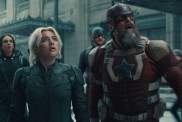Mortal Kombat has been around for over thirty years as a franchise. With that sort of longevity there are bound to be a few duds. However, some forget that the franchise is built off of the triumphs and mistakes they had along the way, learning from everything. Even the worst outings have helped lead future games to success, but it’s the titles in the middle ground that seem to be forgotten about. Mortal Kombat vs DC Universe is often remembered in passing, but few players recall what it did.
The concept was wild. Sure, we had Marvel vs Capcom, but this felt newer and perhaps a bit more special considering the properties. Seeing that cover for the first time, with Scorpion and Batman sizing each other up in a pre-Death Battle world… breathtaking. The premise was simple enough: take an established fighting game series like Mortal Kombat, smash them into each other, and the money will flow. The problem is that the mere idea of pitting these two forces against each other — and making both sides happy — may have promised more than the game could have feasibly delivered at that time.
To confuse most people, this game is often considered to be Mortal Kombat 8, even if that was something that was just meant to be counted internally, it stuck. MK8 started its life differently, somewhat inspired by Gears of War in look and tone, but that work was scrapped when that DC Comics deal popped up. When opportunity like that comes knocking, it is certainly hard to say no. Maybe it should have been a spin-off, sure, but even that wouldn’t have stopped much of the fanbase from trying to take the game too seriously.
That brings us to the question on many minds: is it canon? Yeah, kind of.
MK vs. DC Universe wasn’t a simple cash-in. The game pushed the ideas of presentation in the genre, and attempted to add new features to take a mostly polished fighting system to the next level. New mini-game scenarios were added with Klose Kombat, Free Fall Kombat, and Test Your Might. Each triggered moments outside of the normal fighting structure, where players would have to press specific buttons or outdo their opponents in an attempt to gain the upper hand. They weren’t the most creative thing, but I still prefer them over the Wager/Clash system we’d see later in the Injustice series. There was also Rage Mode, which some see as the precursor to X-Ray and Fatal Blow maneuvers. The early elements of the meter system and enhanced moves are present as well.
The story for this game isn’t usually remembered favorably, but it certainly has some excellent moments past having to make convoluted reasons for the characters to be able to meet and be on an even playing field. The story was mostly penned by DC Comics writers Jimmy Palmiotti and Justin Gray so that the characters on the other side were sure to live up to their counterparts from the pages. This Story Mode was incredibly ambitious for the time, as it was completely voiced and motion-captured. Co-creator Ed Boon had to fight for going to these lengths and it was a good thing he did, as we are still seeing the fruits of that labor today. These factors made MK vs DC feel new and experimental, like risking it all on the company’s dime and having something to show for it, even if everyone didn’t see it.
Some MK fans just cannot see past what is missing here. The deal with DC Comics decreed that their characters had to be treated a certain way, which meant no ripping their spines out or beating them to death with their own appendages. I’d say that they tried, but the team was shackled here, and it looks like they knew the rest of the game would have to make up for what was missing.
The alternative for several characters was Heroic Brutality finishers, which sounds like something I’d expect Homelander to call his form of justice. These are stunningly weak, and looking at them years later, it’s quite sad. Some fans of the comics were legitimately glad to see that they didn’t have their favorites go completely savage and do things that were too far out of character. What softens this blow a little is that this game showed off some excellent battle damage with bruising and costume tearing to make the fights feel more ruthless.
With all of the good things that could be pointed out, there are of course some more questionable elements. There’s that hint of favoritism, especially with DC getting an extra chapter in the Story Mode, and for some reason, the big skirmish at the end wasn’t fully rendered, but that was probably a budget issue. Some of the controls are a bit janky, and there were some balancing tweaks needed, which made this game a less optimal choice for competitive play. There are also very few unlockables other than the split boss characters, but that would have been helped by DLC, had Midway Games not been in financial turmoil. Quan Chi and Harley Quinn were expected to make their way into battle with Kung Lao and Doomsday hinted at for the future.
This game is always going to be piled on somewhat, and that is hard to argue against, but that doesn’t mean MK vs. DC doesn’t deserve a little more recognition. If anything, people should know what it accomplished and how this attempt led to an incredibly successful revival of Mortal Kombat and spawned the Injustice series. That’ll be its legacy: how it helped guide the way to much better games and how we almost got an animated movie of the idea.
There will always be a few people who have seen what Netherrealm has accomplished since then and beg, “Give us Mortal Kombat vs. Injustice.”










